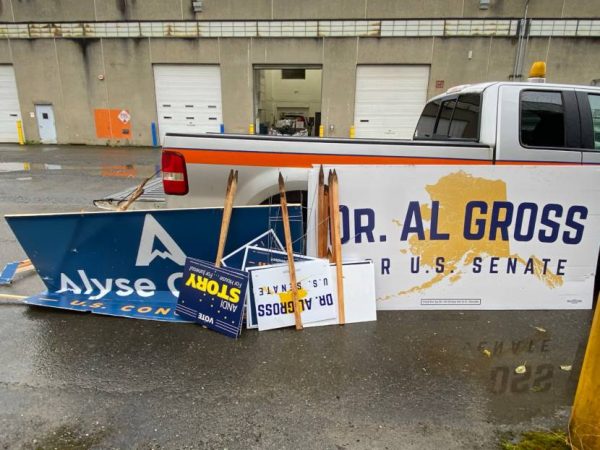
Earlier this month, Ricky Deising of Juneau noticed that two big campaign signs in front of his house had disappeared.
He posted before-and-after photos on Facebook, thinking brazen thieves were responsible. They had to pull the stakes and unscrew them from planter boxes in broad daylight along a state road.
Hundreds of people reacted and commented — including the culprits.
Deising and his landlord who put up the signs declined interview requests.
But within an hour and a half of Deising’s post, the Alaska Department of Transportation and Public Facilities took responsibility. A spokesman wrote that the agency was enforcing a state law that forbids posting most signs in its right of way along state roads.
.The Department of Transportation’s right of way is the real estate it controls for public roads. It does not overlap with private property. It’s reserved for public uses like sidewalks, power lines, drainage ditches and stop signs.
Some commenters suggested the political signs — for independent candidates Alyse Galvin for Congress and Al Gross for U.S. Senate — were pulled for political reasons.
“No way. We are completely equal opportunity,” said DOT’s Michael Schuler, who manages the department’s property in the region, which includes sign enforcement duties. “I mean, right now especially, if there are signs that say, ‘Welcome home, grandma from the hospital, you survived stage 4 cancer,’ and it’s on a mailbox? It’s coming off, because that’s the law.”
Schuler shared photos of recently impounded signs. The names of local, state and national candidates, including Republicans, Democrats and independents, were all there.

Schuler said patrolling for illegally posted signs is tedious, but necessary.
“You know, if we just blew all this off, we would be in jeopardy of losing federal funding,” he said. “And so, it’s kind of the lowest priority that I care to deal with. It’s a bit of a time sink. But it’s one of the requirements, so we do it.”
This incident highlights the court system’s 2018 interpretation of an old law that was aimed at forbidding billboards. The plain language of the law says most signs are banned within 660 feet of the state right of way. That’s two football fields.
But in 2018, an Anchorage Superior Court judge ordered DOT to permanently stop enforcing certain parts of the law over free speech concerns.
Basically, before that decision, DOT was supposed to give 30 days’ written notice to the owners of most signs within two football fields of its right of way. Then it could pull the signs.
Schuler said campaigns had figured out a loophole.
“Before 2018, most of the campaigns were pretty sharp in that they would put the big signs up 30 days before the election,” he said.
The judge’s order allowed most temporary political signs to be placed on private property, regardless of the two-football-field rule. They just can’t be in the state’s right of way.
The judge also said DOT could pull signs from the state right of way without notice. Schuler said that’s cut down on paperwork.
Another complaint on social media was that enforcement of the sign law seems inconsistent.
Schuler said DOT can’t be everywhere at all times, but he thinks the agency is consistently enforcing the law. What’s not consistent is where the state’s right of way ends. In a perfect world, he said, the invisible lines would uniformly parallel the center of the road. But of course, the world’s not perfect.
“So there are lots of in-steps and jogs out all over the place,” Schuler said. “There are very few places that we can just say, ‘Yeah, we’ve got 50 feet, you know, each side of centerline, all the way to the end of the road.’”
It can be tricky, even for him. Schuler is a former survey crew chief who used to be on the ground mapping this stuff out.
He said he’s happy to take calls to help people figure out where they can and can’t put their signs.
This story has been corrected to accurately reflect the state’s definition of right of way.
Jeremy Hsieh is the deputy managing editor of the KTOO newsroom in Juneau. He’s a podcast fiend who’s worked in journalism since high school as a reporter, editor and television producer. He ran Gavel Alaska for 360 North from 2011 to 2016, and is big on experimenting with novel tools and mediums (including the occasional animated gif) to tell stories and demystify the news. Jeremy’s an East Coast transplant who moved to Juneau in 2008.





